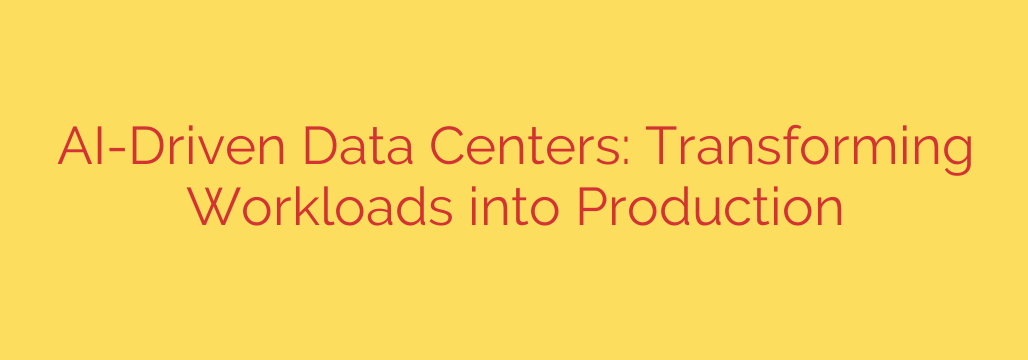
Powering the Future: How AI-Driven Data Centers Are Taking Workloads to Production
The age of artificial intelligence is no longer on the horizon; it’s here. From predictive analytics to generative AI, businesses are racing to harness its power. But behind every revolutionary AI model lies a critical, often overlooked foundation: the data center. Traditional data centers, built for conventional enterprise applications, are simply not equipped to handle the unique and immense demands of AI.
This has given rise to the AI-driven data center—a new breed of infrastructure engineered from the ground up to move complex AI workloads from the experimental phase into full-scale, real-world production. This transition is one of the most significant challenges in technology today, requiring a complete rethinking of computing, networking, and management.
The Unique Demands of AI Workloads
Understanding why AI requires specialized infrastructure starts with recognizing that AI workloads are fundamentally different from traditional software. They don’t just execute code; they learn, adapt, and process information on an unprecedented scale.
The primary distinction lies in two key phases: training and inference.
- AI Training: This is the process of teaching an AI model by feeding it massive datasets. It is an incredibly resource-intensive task, often requiring weeks or even months of continuous, parallel processing across thousands of specialized processors. The goal is to perform a vast number of calculations to allow the model to recognize patterns.
- AI Inference: This is the “production” phase where the trained model is put to work, making predictions or generating content based on new, live data. While less computationally intensive than training on a per-transaction basis, inference must happen in real-time with extremely low latency, often at an enormous scale.
The core challenge is building an environment that can efficiently handle both the marathon of AI training and the sprint of real-time inference. This dual requirement puts immense strain on every component of the data center.
Building the Foundation: Key Pillars of an AI Data Center
An AI-ready data center is not just about adding more servers. It’s a purpose-built ecosystem where every component is optimized for performance and data flow. The three essential pillars are accelerated computing, high-speed networking, and intelligent data management.
1. Accelerated Computing with GPUs
At the heart of every AI data center are Graphics Processing Units (GPUs) and other accelerators like TPUs. Unlike traditional CPUs that handle a few complex tasks at a time, GPUs are designed for massive parallel processing, allowing them to perform thousands of simple calculations simultaneously. This parallel architecture makes GPUs the indispensable engine for training deep learning models. Modern AI infrastructure relies on large clusters of interconnected GPUs working in concert to tackle a single, massive training job.
2. High-Speed, Low-Latency Networking
With thousands of GPUs processing data, the network becomes the central nervous system. A slow or congested network can leave expensive processors sitting idle, creating a critical bottleneck that cripples performance. AI data centers require an advanced networking fabric, often using technologies like InfiniBand or RoCE (RDMA over Converged Ethernet), to ensure seamless, high-bandwidth communication between GPUs and storage. The goal is to create a frictionless environment where data can move at the speed of computation.
3. Optimized Storage and Data Pipelines
AI models are voracious consumers of data. The storage systems that house this data must deliver it to the GPU clusters with minimal delay. This has led to the widespread adoption of high-performance flash storage (like NVMe) and parallel file systems designed to serve billions of small files to thousands of clients simultaneously. Just as important is the data pipeline itself—the entire workflow for ingesting, cleaning, labeling, and managing the data that fuels the AI models.
From Development to Production: The MLOps Revolution
Building a powerful AI infrastructure is only half the battle. The true goal is to reliably deploy, manage, and scale AI models in a live production environment. This operational discipline is known as MLOps (Machine Learning Operations).
MLOps bridges the gap between data scientists who create the models and the IT operations teams who run them. It introduces automation and best practices to the entire AI lifecycle, including model versioning, automated retraining, performance monitoring, and security. Without a strong MLOps framework, moving from a successful prototype to a dependable, enterprise-grade application is nearly impossible. An AI-driven data center must be designed to support these automated workflows, allowing for continuous integration and deployment of AI models with minimal human intervention.
Actionable Security and Strategy Tips
As you integrate AI into your operations, it’s crucial to build on a secure and strategic foundation. Here are four key best practices:
Embrace a Hybrid Cloud Strategy: Not all AI workloads belong in the same place. A hybrid approach allows you to perform massive training jobs on-premises where you control the specialized hardware, while leveraging the public cloud’s scalability for inference and data collection. This flexibility optimizes both cost and performance.
Prioritize Data Governance and Security: Your AI models are a direct reflection of your data. Implement strict access controls, data encryption, and clear governance policies to ensure data integrity and privacy. A compromised dataset or model can pose a significant business and reputational risk.
Implement End-to-End Monitoring: To run AI in production, you must monitor everything. This includes hardware performance (GPU utilization, network latency), model performance (accuracy, prediction drift), and cost. Comprehensive observability helps you proactively identify issues before they impact users.
Invest in a Full-Stack Solution: Piecing together hardware and software from dozens of vendors is complex and inefficient. Look for integrated, full-stack platforms that combine accelerated computing, networking, software, and MLOps tools into a unified, enterprise-supported solution. This simplifies deployment and accelerates your time to production.
The future of business is inextricably linked to artificial intelligence. Building a robust, AI-driven data center is no longer a luxury for tech giants—it’s a strategic imperative for any organization looking to innovate and compete in the modern era. By focusing on a holistic architecture that masters computation, data flow, and operations, businesses can successfully transform their AI ambitions into real-world production value.
Source: https://feedpress.me/link/23606/17174780/from-workloads-to-factories-rethinking-the-data-center-for-ai







